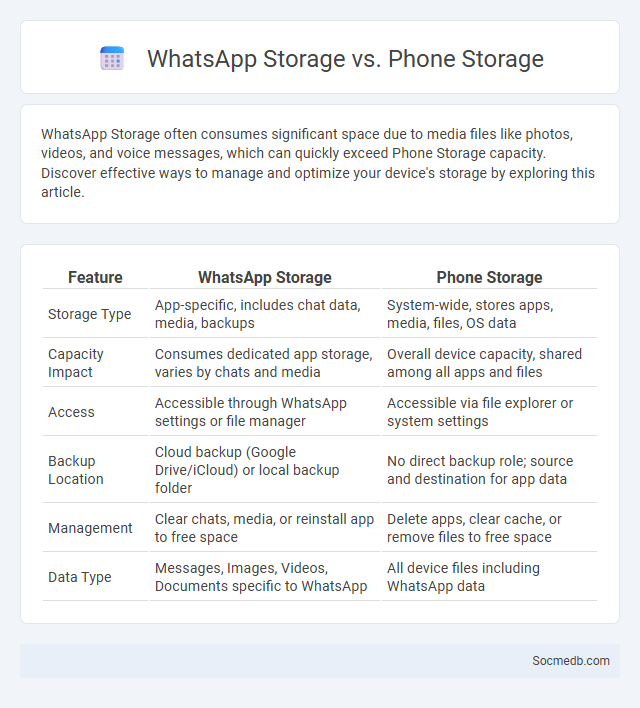
Photo illustration: WhatsApp Storage vs Phone Storage
WhatsApp Storage often consumes significant space due to media files like photos, videos, and voice messages, which can quickly exceed Phone Storage capacity. Discover effective ways to manage and optimize your device's storage by exploring this article.
Table of Comparison
| Feature | WhatsApp Storage | Phone Storage |
|---|---|---|
| Storage Type | App-specific, includes chat data, media, backups | System-wide, stores apps, media, files, OS data |
| Capacity Impact | Consumes dedicated app storage, varies by chats and media | Overall device capacity, shared among all apps and files |
| Access | Accessible through WhatsApp settings or file manager | Accessible via file explorer or system settings |
| Backup Location | Cloud backup (Google Drive/iCloud) or local backup folder | No direct backup role; source and destination for app data |
| Management | Clear chats, media, or reinstall app to free space | Delete apps, clear cache, or remove files to free space |
| Data Type | Messages, Images, Videos, Documents specific to WhatsApp | All device files including WhatsApp data |
Understanding WhatsApp Storage
Understanding WhatsApp storage is crucial for managing your device's memory efficiently, as the app accumulates media files such as photos, videos, and voice messages over time. You can access storage usage details within WhatsApp settings to identify which chats consume the most space, enabling targeted deletion of large or unnecessary files. Regularly clearing WhatsApp cache and backups helps optimize your phone's performance and preserves storage capacity.
How Phone Storage Works
Phone storage works by using internal memory chips to store your operating system, apps, and personal data, such as photos and messages. This storage is divided into two main types: volatile memory (RAM) for temporary data while the phone is running, and non-volatile memory (flash storage) for long-term data retention. Managing your phone storage efficiently helps maintain device performance and ensures you have enough space for your growing social media content.
Key Differences Between WhatsApp and Phone Storage
WhatsApp stores messages, images, videos, and voice notes within its app-specific storage, which is designed for easy access and backup through cloud services like Google Drive or iCloud, whereas phone storage holds all files locally, including app data, system files, and media. Your WhatsApp data typically consumes less phone storage as it uses external backup options and manages media automatically, while phone storage capacity can be quickly depleted by direct downloads and files saved outside apps. Backup frequency and data accessibility are core differences, with WhatsApp emphasizing encrypted cloud backups, contrasting with manual or automatic local backups on phone storage.
Common Storage Management Challenges
Common storage management challenges in social media include handling exponential data growth from user-generated content such as photos, videos, and messages, which demands scalable and efficient storage solutions. Ensuring data integrity and quick retrieval amid vast, unstructured datasets requires advanced indexing and compression techniques. Security concerns, including protecting sensitive user information and complying with data privacy regulations like GDPR and CCPA, add complexity to storage architecture and management.
Impact of WhatsApp Media on Device Storage
WhatsApp media files, including images, videos, and voice messages, can quickly consume substantial device storage, leading to slower performance and limited space for other apps. Managing your WhatsApp settings to auto-download only essential media can help preserve storage capacity and extend the lifespan of your device. Regularly clearing chat backups and deleting unnecessary files ensures optimal device efficiency and frees up valuable space.
Efficient Ways to Manage WhatsApp Storage
WhatsApp storage can be efficiently managed by regularly deleting unnecessary chats, media files, and documents, especially from group conversations that often accumulate large amounts of data. Using WhatsApp's built-in storage management tool allows users to identify and clear items such as forwarded media, large files, and old messages that contribute to storage build-up. Backing up important chats to cloud services like Google Drive or iCloud also helps free up local storage while retaining essential conversations.
Optimizing Phone Storage for Performance
Managing social media apps efficiently can significantly optimize phone storage and enhance overall device performance. Regularly clearing cache and deleting unused media files from platforms like Instagram, Facebook, and TikTok frees up critical space and reduces app load times. Leveraging cloud storage options for photos and videos further preserves local memory, ensuring smoother multitasking and faster response rates on smartphones.
Backup and Restore Options for WhatsApp Data
WhatsApp offers built-in backup and restore options that securely save your chat history and media to cloud services like Google Drive or iCloud, depending on your device. You can configure automatic backups on a daily, weekly, or monthly basis to ensure your data remains protected without manual intervention. Your ability to restore these backups during app reinstallation guarantees seamless access to previous conversations and media files.
Tools and Apps for Storage Management
Social media users rely heavily on tools and apps like Google Photos, Dropbox, and OneDrive for efficient storage management, ensuring seamless backup and retrieval of their multimedia content. Mobile apps such as Files by Google and CCleaner help you optimize device storage by identifying and deleting redundant files from your social media downloads and caches. Leveraging cloud storage integration within platforms like Instagram and Facebook enables secure storage expansion without compromising data accessibility or device performance.
Best Practices for Long-Term Storage Savings
Implement efficient data compression techniques and prioritize storing essential social media content to optimize long-term storage savings. Leverage cloud storage solutions with scalable pricing models to reduce costs and enhance accessibility. You can further improve savings by regularly auditing stored data to delete outdated or irrelevant files.
 socmedb.com
socmedb.com